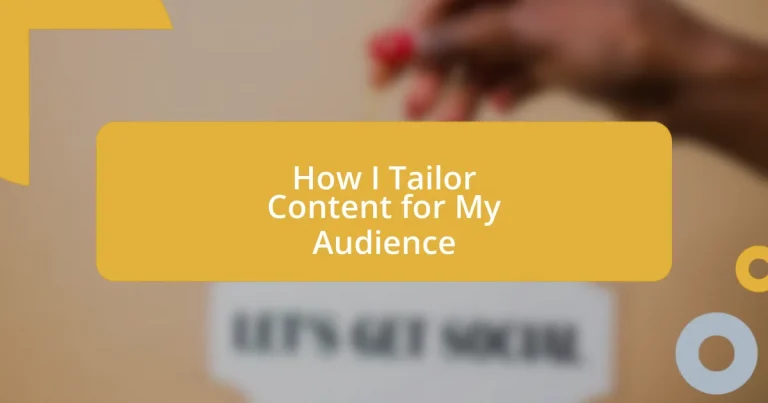Key takeaways:
- Understanding audience needs through feedback and analytics enhances content relevance and engagement.
- Setting clear content goals and adopting adaptable strategies ensure messages align with audience expectations and desires.
- Personalizing content by segmenting the audience and using empathetic language fosters deeper connections and trust.
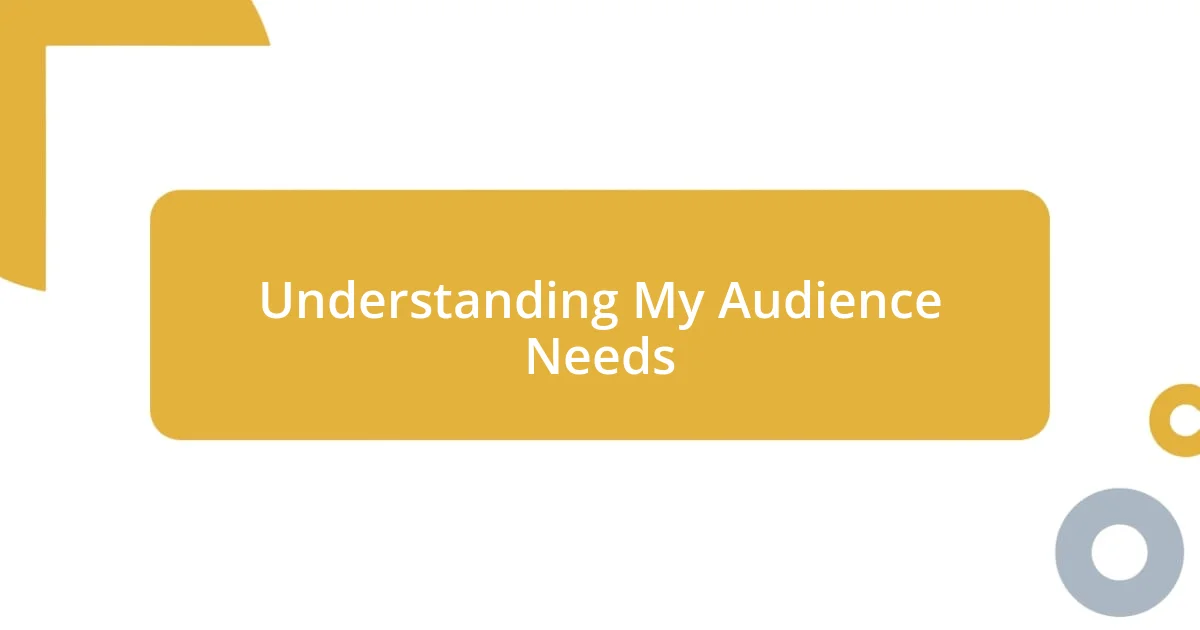
Understanding My Audience Needs
Understanding my audience’s needs is like tuning into a favorite song; I must listen closely to the notes that resonate. For instance, when I first started writing content for a tech-savvy crowd, I quickly realized that jargon wasn’t just appreciated – it was expected. It pushed me to research terms and concepts, allowing me to create deeper, more engaging content that truly speaks to them.
I often ask myself, “What keeps my audience up at night?” This question helps me tap into their challenges and desires. For example, during a workshop, I chatted with a small business owner who expressed frustration about digital marketing. Understanding that pain point sparked a series of articles where I could offer practical strategies just for them, creating a sense of trust and connection.
I also pay close attention to feedback and analytics. When I noticed engagement drop on a particular topic, it made me reflect. Were my readers looking for something different? I revisited my content approach and discovered that they craved actionable insights over theoretical discussions. This shift not only improved my writing but also reinforced my understanding of their ever-evolving needs.
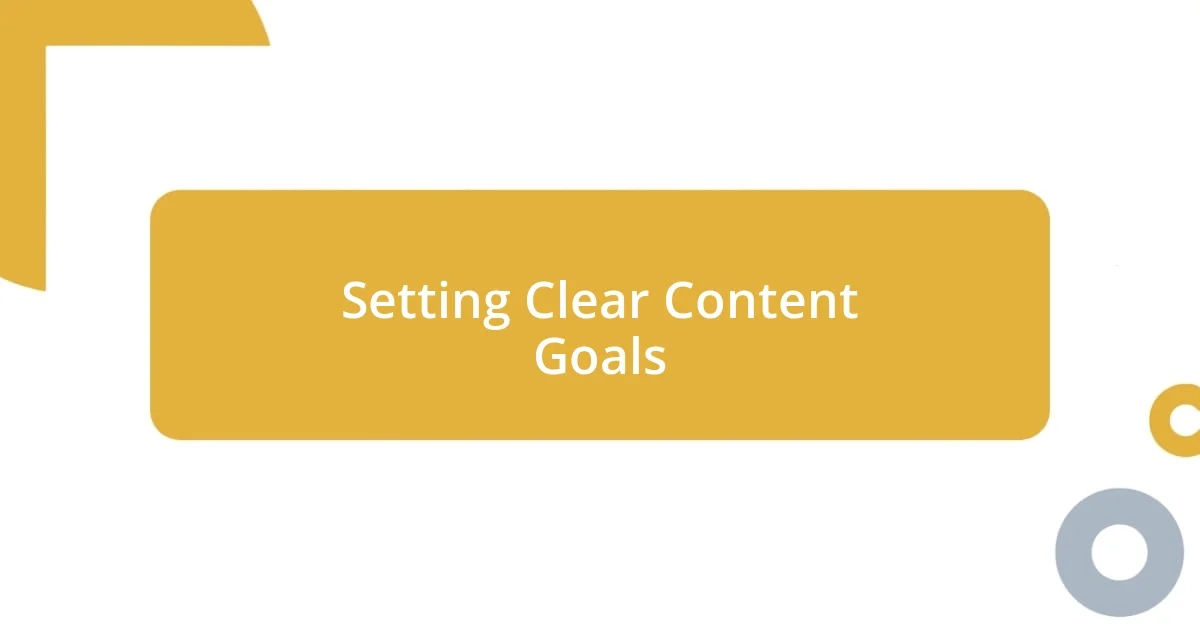
Setting Clear Content Goals
Setting clear content goals is essential for creating messages that truly resonate with my audience. I like to think of these goals as a roadmap; they guide me through the creative process and help ensure that my content remains relevant and impactful. For instance, when I was working with a nonprofit organization, our goal was to increase awareness around a crucial environmental issue. By defining that specific aim, we could tailor our messaging to highlight urgency and inspire action, which ultimately led to a successful fundraising campaign.
Here are some key aspects I consider when setting content goals:
- Identify Objectives: What do I want my audience to achieve after consuming my content?
- Measurable Outcomes: How will I gauge success? This could be through engagement metrics or specific actions taken.
- Audience Relevance: Will my goals directly address the needs and desires of my audience?
- Timeline for Delivery: What is the timeframe for achieving these goals? Setting a clear deadline helps me stay focused.
- Adaptability: Am I prepared to pivot if my goals aren’t resonating or if audience feedback suggests a different approach?
Reflecting on these aspects helps me stay aligned with my content strategy and strengthens my connection with readers. It’s a foundation that shapes everything from the topics I choose to the way I present my ideas.

Researching Content Preferences
Researching content preferences is crucial for effective communication with my audience. I often dive into surveys and polls to gather direct feedback, which feels like having a conversation with my readers. One time, I sent out a questionnaire after publishing a new series on social media trends. The responses were eye-opening; people wanted more practical tips instead of just theory. This experience taught me the power of asking questions – it’s not just data, it’s a roadmap to content that truly resonates.
Analyzing competitors can also provide valuable insights. I remember spending hours reviewing what similar creators were doing, which helped me identify gaps in the market. I discovered that while others were deep-diving into algorithms, nobody was talking about the human element of social media engagement. This insight pushed me to craft articles that encompass both the technical and relational aspects, ultimately leading to a more rounded approach.
Lastly, keeping an eye on emerging trends is fundamental. I often browse trending topics on various platforms to see what’s gaining traction. This proactive approach has allowed me to stay ahead of the curve. For instance, when I noticed a surge in discussions around mental health in the workplace, I immediately pivoted my content plan. That not only aligned me with the current conversation but also showed my audience that I’m in tune with their shifting interests.
| Research Method | Insights Gained |
|---|---|
| Surveys and Polls | Direct feedback on content preferences |
| Competitor Analysis | Identification of market gaps |
| Trend Monitoring | Alignment with current topics of interest |

Crafting Engaging Content Formats
Crafting engaging content formats is all about experimenting with different styles and structures. I remember the first time I decided to turn a standard article into an interactive quiz – it was both nerve-wracking and exhilarating. The feedback was overwhelmingly positive, with readers expressing that it made the content not only fun but also memorable. This taught me the importance of not sticking to traditional formats; sometimes, shaking things up can lead to greater engagement.
I think about the various content formats that resonate with my audience, such as infographics or video snippets. One particular instance that stands out was when I transformed a complex set of data into a visually appealing infographic. Not only did it simplify the information, but the sharability factor soared. How often do we scroll past walls of text? Visuals immediately capture attention and can communicate messages more effectively than paragraphs ever could.
Then there are storytelling elements that can amplify engagement. I often weave personal anecdotes into my posts, creating a sense of connection. Sometimes I ask myself, “What story do I have that aligns with this topic?” For example, discussing failure can foster relatability; sharing my own missteps in a project not only humanizes me but also encourages readers to see their own challenges in a new light. When content taps into emotions, it transforms from mere words into a shared experience, making it truly engaging.
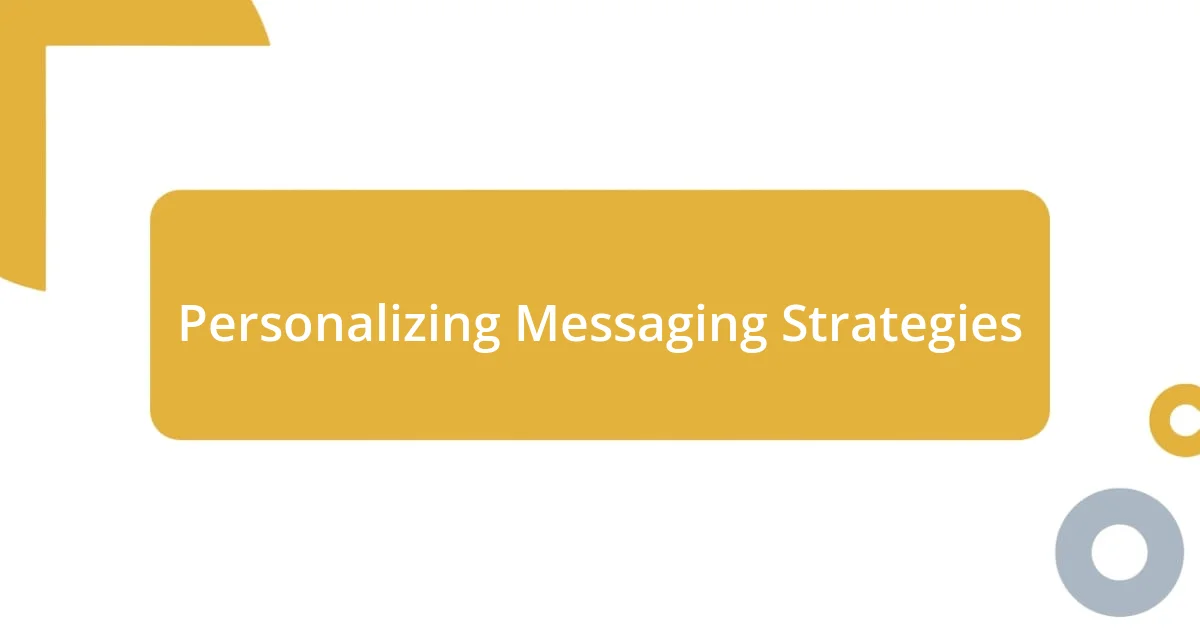
Personalizing Messaging Strategies
Personalizing my messaging strategies means getting to the heart of what my audience truly wants. When I was developing content for a wellness blog, I tried segmenting my audience by age and lifestyle, and I discovered that younger readers preferred quick, actionable tips while older audiences appreciated in-depth articles. This insight drove me to create two versions of my newsletters, successfully meeting the different needs of my subscribers. Wouldn’t you agree that if we tailor our messages, we can strengthen those connections?
Another technique I’ve embraced is using specific language that resonates with my readers. For instance, I once wrote an article targeting new parents and made a conscious effort to use relatable phrases that captured the chaos of sleepless nights and diaper changes. I remember receiving a comment from a reader who said, “I felt like you were in my shoes!” That made me realize the power of empathetic language—it can turn information into something profoundly relatable.
Moreover, tapping into audience emotions is a cornerstone of my strategy. I’ve found that sharing not just successes but struggles too creates a bridge of trust. Recently, I opened up about my challenges with maintaining a work-life balance, and the responses flooded in. Readers shared their own experiences, highlighting a community built on shared vulnerabilities. Isn’t it interesting how authenticity can foster deeper engagement? By personalizing my messaging, I felt that I wasn’t just a content creator; I became a companion on their journey.
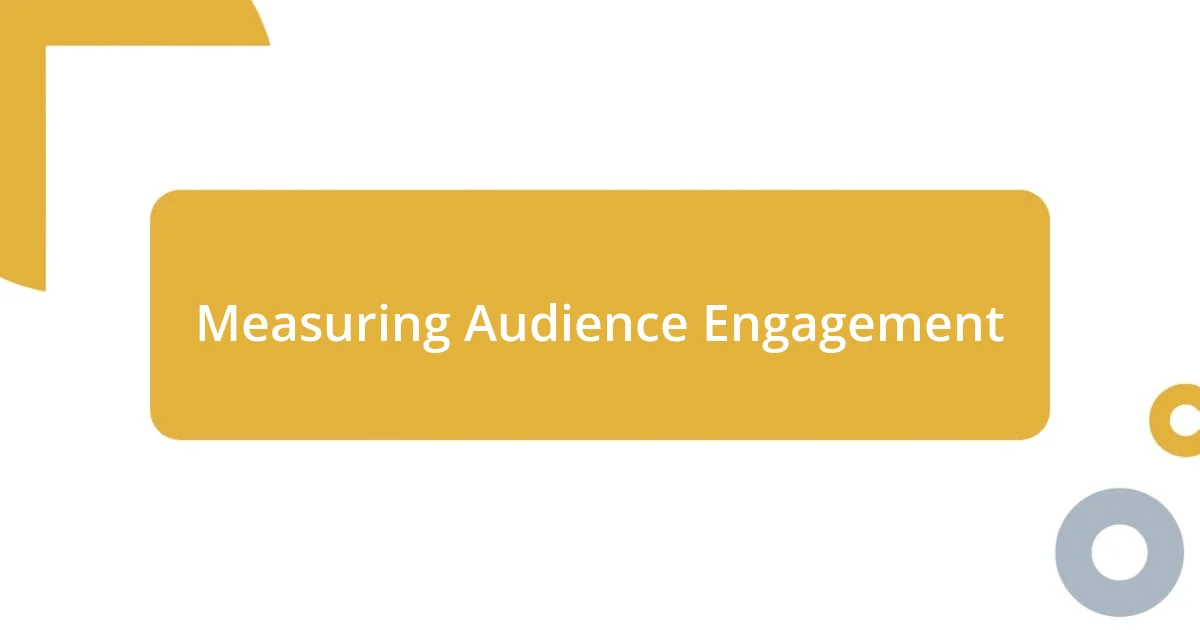
Measuring Audience Engagement
Measuring audience engagement hinges on understanding how your content resonates with your readers. In my experience, I often delve into analytics tools to track metrics like click-through rates, time on page, and social shares. It’s fascinating to see how a single tweak—like changing a headline or shifting the position of an image—can lead to a notable increase in engagement. Have you ever felt that spark when you realize a small change made a big impact?
Surveys and direct feedback are also invaluable in measuring engagement. I remember conducting a quick poll after a particularly successful blog post, asking my audience what they enjoyed most. The responses not only highlighted what worked well but also sparked new ideas for future content. Engaging my audience in this way made me feel like we were part of a collaborative dialogue. Isn’t it rewarding when your readers guide your content creation process?
Additionally, I’ve found that monitoring comments and social media interactions can provide real-time insights into engagement levels. Last month, for instance, I noticed a spike in comments during a series on mental health. Each comment revealed not only how the content resonated but also the need for more discussions in that area. Isn’t it amazing how conversation threads can help shape the direction of future content? Understanding these interactions strengthens my connection with the audience and encourages me to keep exploring topics that matter to them.

Adapting Content Based on Feedback
Feedback is like a compass guiding my content creation journey. I vividly recall a time when I published a video tutorial on budgeting tips. After I received mixed reactions—some found it helpful, but others craved more real-life examples—I took it to heart. I decided to create follow-up videos that included actual budgeting scenarios from my life, demonstrating how I navigated difficult financial choices. Have you ever adjusted your approach after hearing your audience’s responses? It’s incredibly liberating to know that feedback directly shapes how I connect with my community.
One of the most profound shifts I’ve made based on audience feedback involved developing a series on mental health. Initially, my content focused on general tips, but many readers voiced a desire for deeper discussions about specific struggles they face. This revelation encouraged me to curate guest posts from mental health professionals and even share my own stories of vulnerability. It felt empowering to transform their feedback into substantive articles that balanced honesty and support. What do you think happens when we truly listen to our audience? I believe it fosters a sense of belonging, showing that they’re not alone in their experiences.
In my experience, adapting to feedback has also meant embracing spontaneity. I remember a live Q&A session where a viewer asked about coping mechanisms for anxiety during stressful times. The question struck a chord, prompting me to pivot my next few posts to explore this topic in depth. It’s astonishing how a single inquiry from my audience can uncover a wealth of content potential. Have you felt that exhilarating moment when a conversation unlocks new ideas? By staying flexible and responsive, I build a richer tapestry of content that directly reflects my readers’ needs and desires.












